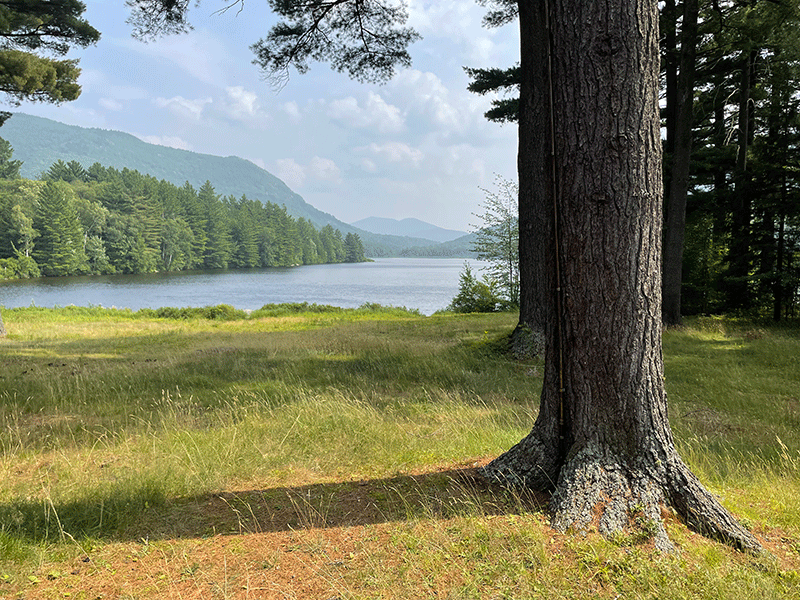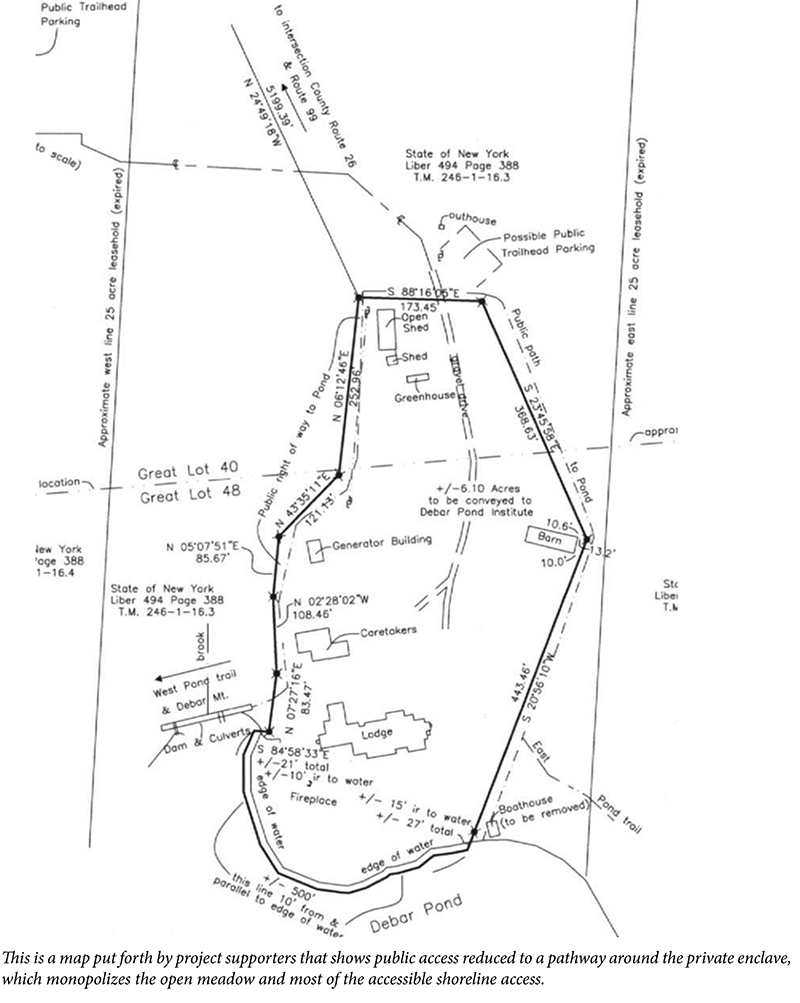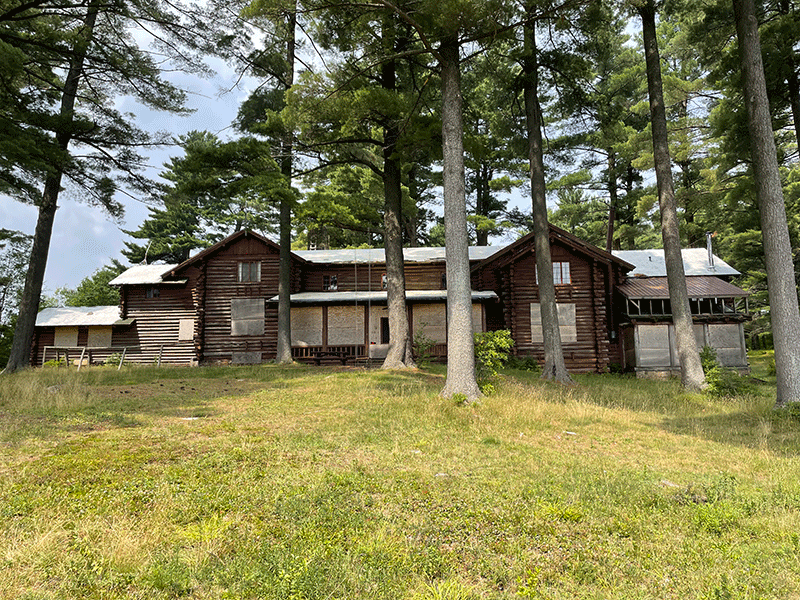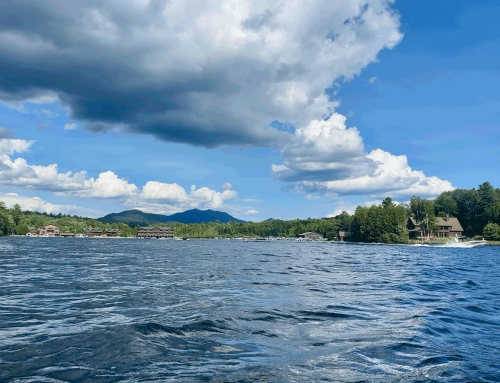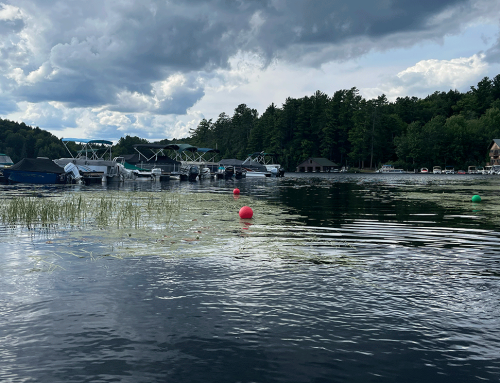Protect the Adirondacks opposes legislation for an amendment to Article 14, Section 1, of the New York Constitution to remove six acres of public lands from the constitutionally protected Adirondack Forest Preserve. The affected lands provide public access to Debar Pond in the Debar Mountain Wild Forest area and include some decrepit buildings that should be demolished and removed. The proposed constitutional amendment would convey into private ownership an area is used by the public seeking remote, wild experiences on an otherwise undeveloped lake. The existing buildings, known as Debar Lodge, are dilapidated and will costs millions of dollars to restore for their proposed new use as some kind of private institute. If the deal goes through, public access will be sharply reduced from what we all enjoy today. This is a bad deal for public recreation, for wild places, and for the forever wild Forest Preserve.
Supporters of resuscitating Debar Lodge want to reduce public access to a side path on the edge of the private compound, while the paying guests of the renovated Debar Lodge complex will be able to monopolize the area with the best access to Debar Pond. The public will be allowed on the grounds of the private enclave for a fee or with a conference reservation.
Debar Lodge and other buildings should be removed, the site should be restored, and Debar Pond should be managed as a wild, motorless lake. Debar Pond could be another Lake Lila — accessible, yet wild. There is a far greater need in the Adirondack Park for more Lake Lilas than there is for another private retreat center.
There are many reasons why the effort to resurrect an outdated and dilapidated lodge and remove these lands from the Forest Preserve is a bad idea.
The Proposed Constitutional Amendment Will Strip Public Recreational Rights and Use: Creating a private 6+/-acre complex around the old lodge buildings will undermine and greatly weaken public access to Debar Pond. Supporters of the amendment seek to create a private compound where public access to Debar Pond will be greatly diminished. The lands that the proposed amendment would transfer from public to private ownership include (i) the principal public access point to Debar Pond; (ii) an open grassy area between the old lodge buildings and the lake that is a popular site for picnics and family activities; and (iii) the most popular and easiest route to carry a canoe to the Debar Pond.
The public has enjoyed unfettered access to the Debar Lodge lands for more than a decade. State taxpayers purchased these lands more than three decades ago and have paid all local taxes on these lands since the purchase. The public has enjoyed the parking area and short walk or canoe carry through the grounds to Debar Pond. Public use has significantly increased in the last half dozen years since the Department of Environmental Conservation (DEC) stopped using the site to house its staff, a practice of questionable legality. Protect the Adirondacks is greatly concerned about efforts to privatize and significantly diminish the public’s access to these lands. We believe that transferring these precious public lands to private ownership will seriously and irreparably damage public access to and enjoyment of Debar Pond. See a map below.
In our meetings with amendment supporters, they were adamant about needing exclusive, privately controlled access to the Debar Lodge site to conduct their activities. Project supporters made it clear that unfettered public use, a hallmark of the Forest Preserve, is incompatible with the redevelopment of the Debar Lodge contemplated by this amendment.
Protect the Adirondacks opposes transferring important public access and recreational lands into private ownership and limiting the public’s access to this remarkable part of the Forest Preserve to a narrow pathway around a private compound. The proposed amendment would transform members of the public into illegal trespassers on lands that were purchased by the State for the use and enjoyment of the public. We cannot support a proposal that strips away the rights of New Yorkers to the best access for Debar Pond.
The Lake Lila Model is the Best Historic Precedent for Debar Lodge and Debar Pond: The State of New York purchased Lake Lila and several thousand acres around it in the 1970s. Part of the purchase included Nehasane Lodge on the west end of Lake Lila. Peter Berle, then DEC Commissioner, oversaw the demolition and removal of that Great Camp and associated buildings. Today, Lake Lila is a treasured part of the William C. Whitney Wilderness area and has been enjoyed by hundreds of thousands of people for more than four decades for its beauty and wildness. Had Nehasane Lodge remained, the entire Lake Lila experience today would be fundamentally different and significantly diminished.
Lake Lila’s restoration and its classification as Wilderness is one of the great success stories in the Adirondack Park. Today, Lake Lila provides a stunningly beautiful Wilderness landscape and experience, and provides more than two dozen wilderness campsites. The lake is heavily used by the public all summer long, year after year. We believe that former DEC Commissioner Berle’s vision for Lake Lila was prescient and was the right decision because wild, motorfree lakes have only grown rarer and more precious in the last 50 years. Lake Lila would be a very different place today had Nehasne Lodge been preserved and/or privatized.
Protect the Adirondacks believes that the Lake Lila model is the best model for Debar Lodge and Debar Pond.
Wildness is the Overriding Forest Preserve Value at Debar Pond: Protect the Adirondacks has a fundamentally different vision for the Debar Lodge property than amendment supporters who seek to privatize the property. In our vision, Debar Pond would be a place that is managed to grow even wilder in the future than it is today. In our vision, Debar Pond would be another Lake Lila or Boreas Pond or Little Tupper Lake or Henderson Lake, a motorfree and wild lake where the public can canoe, hike and camp, in a landscape that grows wilder decade after decade. We note that public use at Debar Pond has tripled in the past several years. According to DEC, the increase in public use is the result of the abandonment of Debar Lodge as a residence for DEC personnel, which made the site more open and welcoming to the public. Turning Debar Lodge into a private enclave would reverse this trend and discourage public use of Debar Pond.
We see Debar Pond as a special and accessible wild area, a place where grandparents can one day bring their grandchildren to experience wildness in much the same way, unchanged and beautiful, as they experienced Debar Pond as children themselves. There is nothing better to illustrate the promise of the public Forest Preserve in New York State than this kind of generation after generation enjoyment of wild nature at beautiful and timeless locations.
The Proposed Deal Provides Inadequate Compensation for the Forest Preserve: Supporters aim to “compensate” for the loss of the 6 acres around Debar Lodge by giving 400 acres of lands elsewhere to the Forest Preserve. This tract sits between the Meecham Lake access road and State Route 30. On its face, a 6 acre for 400-acre swap may seem like a good deal, but the 400 acres proposed contain no shoreline. This is hardly an equitable trade. This tract is assessed by the local town at $223,000 at full market value. It’s classified as timberlands in the tax code. Vacant forest lands run at about $1,000 per acre, so the 400 acres, far from just about everything, is probably something like $400,000 in value.There are many lakes in the Adirondacks where one cannot buy a building lot for $400,000. The exclusive setting of the Debar Lodge complex on what is basically its own private lake makes this trade uneven, basically a rip-off of the Forest Preserve and New York State taxpayers.
Debar Lodge is in disrepair, but it is the sole building complex on an otherwise undeveloped lake. Similar properties with one private group of buildings on an otherwise undeveloped lake in the Adirondacks go for big bucks. Consider Windfall Pond, a 1,615-acre lake with a modest camp. It’s valued at around $1.2 million. Or consider the 588-acre Dexter Lake once owned by Shania Twain. There’s a new 8-bedroom, 9-bathroom mansion on the lake, which sold for $4.1 million in 2007 and is assessed at nearly $8 million today. The Masten House in Newcomb sits on a 42-acre private lot on Henderson Lake, which is otherwise all Forest Preserve. The property sold recently for over $2 million. There are two private inholdings on Forked Lake, which is largely Forest Preserve, one valued at $2.2 million. There are many others.
The draft amendment includes an easement over the property if it is transferred. That easement mandates limited and strictly defined public access to the grounds. Supporters argue that this access, and required but limited public parking and public disabled access, diminishes the value of the property. It remains a property in an exclusive setting and it should not be given away. This effort, regardless of how supported dress it up, remains a project that privatizes a public asset and constricts public use.
The draft amendment states that the 400 acres that are to compensate the removal of the 6 acres and buildings must be “at least equal in value to the lands and buildings conveyed by the state.” The proposed trade falls short and is in no way equal in value. Why would the People of the State of New York agree to such a bad deal? We think they would not.
Adirondack Great Camp Social and Architectural History is Already Adequately Preserved and Interpreted: Many Adirondack Great Camps recognized for their architectural and social history are protected and have been restored by private owners across the Adirondack Park. With a few exceptions, most of these camps are located on relatively small acreages and it is therefore unlikely that they would be part of any future public land purchases for the Forest Preserve. The future of these several dozen Great Camps is reasonably secure because they are privately owned and maintained. Many of these camps have been recognized for their architectural significance and have been showcased at times for public tours.
Great Camp Santanoni on Newcomb Lake is an inholding of sorts within the High Peaks Wilderness. This Great Camp was purchased in the 1970s as part of a 12,000-acre purchase of lands that were added to the High Peaks Wilderness. Great Camp Santanoni existed in a state of benign neglect for decades. A state law was passed to allow its buildings to remain on the Forest Preserve if they met a specific purpose. The Great Camp Santanoni complex, and its access road, remain in the Forest Preserve and were classified as a Historic Area under the Adirondack Park State Land Master Plan (APSLMP). The grounds around the buildings remain accessible and available to the public for free.
Great Camp Santanoni was eventually stabilized with state funding beginning in the early 2000s. The first iterations of the APSLMP in the 1970s did not have a Historic classification, but it was added in subsequent revisions. The State of New York has spent millions of dollars to stabilize and restore Great Camp Santanoni, which functions today as a living museum. The most recent state budget allocated another $500,000 from the Environmental Protection Fund (EPF) for Camp Santanoni in this year’s budget.
The continued existence of Great Camp Santanoni is an attraction for many people and considered an important cultural resource in the Town of Newcomb. However, the Camp’s presence has diminished the public wild experience on Newcomb Lake. The Historic Area has also created management issues related to use of snowmobiles to ferry staff and supplies to the Great Camp during the winter, state administrative use of motor vehicles on the access road in summer, months, and staff living in the “historic” buildings on site. Despite these problems, we recognize that Great Camp Santanoni provides a viable public education and interpretation experience for Adirondack Great Camp architectural and social history. That said, we see no need for the preservation of another Great Camp on the Forest Preserve, especially one where the entire property, buildings and grounds, will be closed to the public.
Great Camp Sagamore has also been preserved and fully restored. As we see it, there is no better preservation effort in the Adirondacks, and no better educational effort in the Adirondacks, for Adirondack Great Camps. Great Camp Sagamore is a fully restored Great Camp complex of more than two dozen buildings that sit on Sagamore Lake’s shore. Two Article 14 amendments in the 1980s transferred Great Camp Sagamore and more than a dozen acres to a private institute for educational purposes. The Sagamore Institute has worked since the 1980s to provide public education and interpretation about Adirondack Great Camp architectural and social history. The facility is also used for private conferences and events such as weddings.
Sagamore Institute provides the most indepth educational opportunity for Great Camp architectural and social history in the Adirondack Park for paying customers and school groups through guided tours. While the Great Camp complex has been fully restored, the public experience on Sagamore Lake has always been circumscribed by the Great Camp. Sagamore Lake is no Lake Lila, but had the Great Camp been removed over 40 years ago it would be as stunning and wild as Lake Lila is today.
Today, public access to Sagamore Lake is sharply curtailed by the private Great Camp, where only paying customers can roam its grounds. Public parking areas and access to the lake have never been adequately developed, largely because the private institute resisted them. The guests at the Great Camp enjoy easy lake access from a restored boathouse and series of docks, which are off-limits to the public. The Great Camp Sagamore complex dominates the lake where members of the public are in essence second-class citizens. We do not want that second-class citizen experience for the public repeated at Debar Pond.
Protect the Adirondacks recognizes the necessity of compromise in the management of the Adirondack Park. We realize that the Adirondack Park of today is forged from a series of decisions and compromises made decades ago. However, we do not believe the public needs another Great Camp Sagamore situation where they become trespassers on formerly public lands. We believe that the Lake Lila/Great Camp Nehasane model is the most appropriate one for Debar Lodge. We believe that the Debar Lodge complex should be removed, and the site restored to a Wild Forest setting. In this way, we’re confident that Debar Pond will grow wilder and even more beautiful in future decades.
We believe that there is no greater gift to future generations than wild spaces around a restored, wild, and motorfree Debar Pond. The world needs more wild spaces, which every year grow fewer. We need wildness far more than we need another private retreat center.
Make Debar Pond into another Lake Lila.

